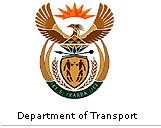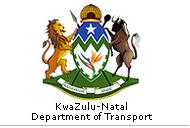 |
Port of Richards Bay
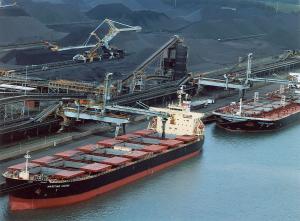
Loading of coal at Richards Bay
|
IntroductionA number of factors contributed to the development of Port
of Richards Bay in the 1970s. It had become urgent to
provide additional rail links between the coast and the
mining heartland of the country. It was also necessary to
provide a deepwater port to accommodate the new large bulk
carriers. From three possible sites for a new harbour, the
choice fell on Richards Bay for five important reasons:
the large lagoon; the ease of dredging; direct link with
the national rail network; an adjacent town, Empangeni, to
stimulate initial development; and ample fresh water.
In May 1972, parliament authorised the construction of the
harbour in Richards Bay, and on 1 April 1976 the first
phase of the harbour was officially opened. Built for the
export of coal, it has since expanded into other bulk and
breakbulk cargoes. Richards Bay is South Africa’s
premier
bulk port and the most modern. In 2005 the port handled 89
million tons of cargo. Richards Bay handles in excess of
80 million tons annually, representing 55% of South
Africa’s seaborne cargo. This makes it the
country’s largest
port in terms of volumes handled.
Richards Bay serves the coalfields of KwaZulu-Natal and
Mpumalanga as well as timber and granite exporters from as
far away as the Eastern Cape and Northern Cape. The port
is now handling an increasing variety of bulk and neobulk
cargo in addition to breakbulk. Much of the general cargo
has migrated away from Durban in recent years. Exports
remain the main activity of the port. Port LayoutSituated at longitude 32º 02' E and latitude 28º
48' S,
Richards Bay, South Africa's most northern and
easterly port, is 87 nautical miles (160 km) northeast of
Durban and 252 nautical miles (465 km) southwest of
Maputo. The port occupies 2,157 ha of land area and 1,495
ha of water area, but has the potential to expand when
required, making it potentially one of the largest ports
in the world. The entrance channel is dredged to a
permissible draught of 17,5m with a -19,5m depth in the
entrance channel.
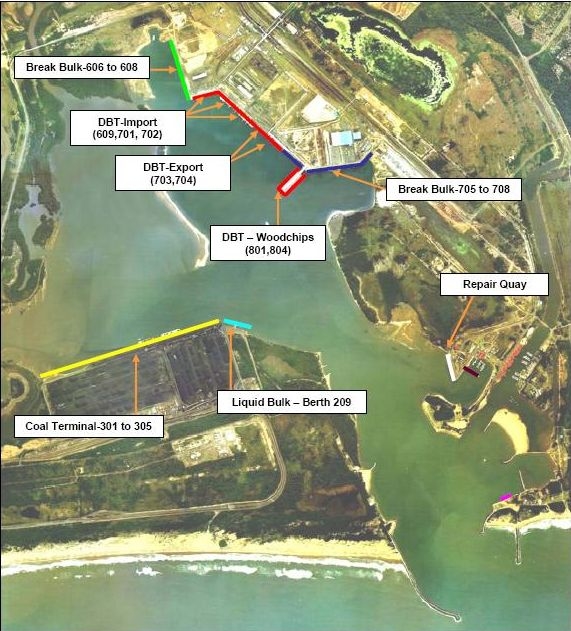
Aerial layout view of Port of Richards Bay
|
The outer anchorage is situated approximately 3-5 nautical
miles south-east of the port entrance. An inner anchorage
is available for emergency use only.
The anchorage immediately to the north of the harbour
entrance channel is a
prohibited area due to the location of an offshore
pipeline.
Pilotage is compulsory for all vessels, and there is a
fleet of five tugs owned and operated by the Transnet
National Ports Authority (TNPA).
Berthing depth varies between 8m (small craft berth) and
19m (coal berths). DocumentationImmigration
Two Crew Lists
Customs
Two Crew Lists
One Ships Store List
List of Narcotics
One Customs DA5 form
One Declaration of crew's personal effects
Load line/Safety Radio/Equipment Cert
Port Health
One Vaccinations List
One Crew List
One Maritime Declaration of Health
Ships Agency
Two Crew Lists
One copy of Ship’s Register
One copy of International Tonnage Certificate (1969)
One copy of International Safety Management
Certificate Port Facilities:Berth Lengths and Draughts
All berths are fitted with fenders. Berthing gangs are
provided by Transnet National Ports Authority, and the use
of this service, is compulsory. There are at present 21
berths in
service, including those at the privately operated
Richards
Bay Coal Terminal but excluding the dredger and tug
berths. An additional coal berth is currently under
construction.
The port of Richards Bay contains a dry bulk terminal, a
multi-purpose terminal and the privately operated coal
terminal. Other private operators within the port include
several wood chip export terminals and a bulk liquid
terminal. The port has extensive rail and conveyor belt
systems servicing the berths from nearby factories and
plants. Richards Bay Coal Terminal (RBCT)
During its 2005 financial year the Richards Bay Coal
Terminal (RBCT) handled 68,35 million tons of export coal,
an increase of 2,3% on the previous year (66,83m in 2004).
The terminal is currently undergoing a refurbishment to
increase its capacity to 92 million tons annually. Ships
are handled at four berths (301-304), each 350m in length
with a -19m water depth alongside and a permissible
draught of 17.5m. The adjacent 209 chemical berth is 300m
long and has a depth alongside of -14m with a permissible
draught of 12.5m.
Trains with an average payload of 16,800 tons on 200
wagons deliver coal to RBCT in a continuous process that
sees 30-35 trains per day arrive at the terminal.
A maximum of 6 million tons of coal can be stockpiled at
the
terminal. There are 80km of rail track within the RBCT
complex. The terminal has handled well in excess of 1
billion tons of coal for export since opening. The coal
terminal at Richards Bay has four ship loaders, two of
which have a nominal loading rate of 8,500 t/h, one with a
rate of 10,000 t/h, and the fourth with a rate of 11,000
t/h. By ratio, it is conceivable that RBCT can at this
stage achieve a total throughput of 77 million tons.
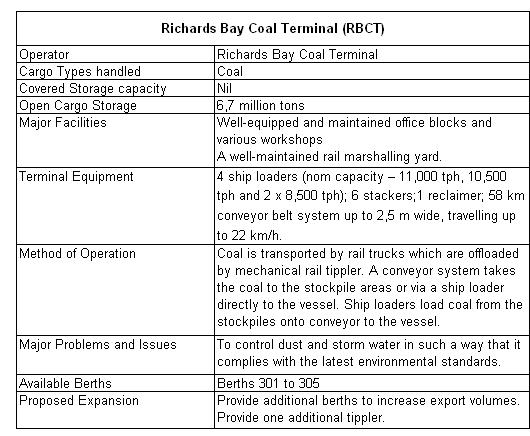
|
Richards Bay Dry Bulk Terminal
The terminal has the use of three import and five
export berths. Total throughput capacity is 18 million
tons per annum. Extensive use is made of multiple use
conveyor systems which require thorough cleaning after
each commodity. The terminal currently handles about 12
million tons of dry bulk cargo annually for import and
export, consisting mainly of ores and mineral cargo.
In 2005/2006, the Woodchip Terminal, which is situated at
berths 801 and 804, exported 4.6 million tons at an
average berth occupancy of 65 %. A high-volume woodchip
loader commissioned in 2004 has made this terminal one of
the world’s best and most efficient woodchip loading
facilities. The general export berths (703,704) handled a
combined total of 2.8 million tons during the 2005/2006
financial year. During this period, an average physical
berth occupancy of 70 % was achieved. The throughput
capacity of the terminal has been upgraded from 11 to 18
million tons per annum. The land surface area is 60,2
hectares.
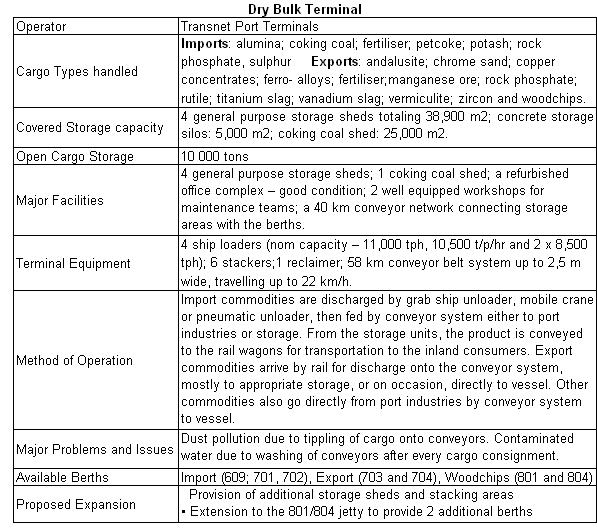
|
Richards Bay MPT
The Richards Bay Multi-Purpose Terminal is the product
of the merging of two
separate terminals, namely the Bulk Metal and Combi
terminals. The resultant
integration of infrastructure and facilities has enhanced
the terminal’s ability to
manage a variety of cargo types, namely breakbulk, neobulk
and containers. The MPT terminal operates 24 hours a day
and is open for 363 days a year. The multi-purpose
terminal specialises in raw and semi-processed materials
such as steel, ferro-alloys and forest products. The
terminal currently operates across seven berths in the
port. The terminal has a throughput capacity of 5,6
million tons per annum and covers a land surface area of
62,2 hectares.The terminal has extensive warehousing and
covered storage areas for sensitive cargo, and a huge open
storage area comprising 330,000m² for cargo
handling. A
specialised 75,000m² ferro-alloy handling facility is
available.
In 2005/2006, berths 705 to 708 handled a total of 3.9
million tons, with an average occupancy factor of 70 %.
These volumes were made up of forest products, aluminium,
ferro metals, pig iron, bagged cargo and containers. The
port of Richards Bay presently handles small volumes of
containers (approximately 5,179 TEUs per annum), which are
handled through berths 706 to 708 by means of ship’s
gear
and mobile cranes. These berths are considered to have
reached their capacity based on present operations (950
000 tons per berth). In comparison, berths 606 to 608
handled 1.1 million tons of breakbulk cargo (scrap metal,
granite and ferro-chrome) in 2005/2006. The average berth
occupancy was 50%. Berths
K 606,607 & 608 - permissible draft 13,5m
K 705 - permissible draft 17,5m
K 706, 707 & 708 - permissible draft 13,5m
Commodities/Cargoes
• Ferro-alloys • Steel • Pig iron
• Forest products • Aluminium •
Project cargo/Heavy
lifts
• Containers • Loose bulk • Pitch
coke
• General (e.g. bags/ drums) • Scrap steel
and granite Richards Bay Liquid Bulk Terminal
Richard Bay has a single dedicated liquid bulk berth
(Berth 209) which handled 1,129 051 tons of bulk liquids
in 2005/2006 The maximum vessel size permitted alongside
berth 209 is 225 metres LOA (lenth overall), 12,5 metres
draft or not more than 67 000 dwt.
Berths 209 along with berths 301 and 302, also have bunker
points. Bunkers can also be provided by a bunker barge at
all berths. Other Private OperatorsSasol Agri
Operator: Sasol Agri.
Commodity: Phosphoric acid.
Storage: In 4 tanks of 11,000 tons capacity.
Equipment: Pipeline operation (connect pipes to
tankers).
Berths: 608/ 609 - permissible drafts of 13,5m and
14,0m.
Land surface Area: 1,309 hectares. Marine ServicesA fully equipped diving service is available for ship
inspection. Ship repair is undertaken at the quayside
(usually the small craft berth), as the port currently has
no ship repair facilities, although a large facility is
being planned. A dry or floating dock is under
consideration.
Cruise ships make use of either the small craft berth or
one of the normal cargo-handling berths, depending on the
size of the ship. There is a modern marina at the small
craft basin. Water sports and recreational facilities are
available in the harbour at reserved places. Marine CraftRichards Bay operates a fleet of five tugs owned and
operated by the Transnet National Ports Authority (TNPA).
Four of
these are identical Voith Schneider-type craft built in
1974 with 43-ton bollard pull - Ibakhu (formerly JH
Botha), Indwa (formerly Jan Haywood), Uhuva (ex W Marshall
Clarke), and Uzavolo (formerly RH Tarpey). Two are for
sale. The fifth tug is a Voith Schneider-type named
Indlazi, built in 2002 with a bollard pull of about 55
tons. The tugs are maintained to SAMSA class 8 standard,
and are equipped for fire fighting and salvage.
The port also employs a twin-screw diesel work boat/tug of
the Tern class named Swift Tern, which has a bollard pull
of 19 tons. This vessel entered service at Richards Bay in
September 1998, and also provides pilotage transfers when
necessary.
A pilot service was provided by an Agusta A109 K2 'HPS'
twin-engine 8-seat helicopter which was operated by
Balmoral Maintenance Services. The aircraft based at
Richards Bay, however, was involved in an accident and has
yet to be replaced. In the meantime, two diesel-powered
pilot boats (named Ivubu and Ballito) are in service.
Dredging is performed by the TNPA on an continual basis
inside the port and immediately outside the entrance,
using a trail suction hopper dredger named Ingwenya
(formerly HR Moffatt). The port operates a single screw
launch named Piet-my-Vrou.
The NSRI base at Richards Bay includes a deep-sea rescue
craft. General
• Repairs - Facilities exist for most types of
repair work to vessels. No dry-dock available. Diving and
engineering companies available.
• Dock ship repair facilities - No dry-dock
available.
LinkagesA dedicated railway line connects the port with Mpumalanga
and Gauteng, and was designed specifically to handle the
majority of South Afroca's coal exports. Other rail links
connect Richards Bay with Durban in the south, and
Swaziland and Mpumalanga to the north. There is an
adequate road system to Gauteng, Swaziland, Mozambique and
Mpumalanga, and an excellent road south to Durban. The
port has extensive rail and conveyor belt systems,
servicing the berths from nearby factories and plants.
Port VolumesThe table below illustrates the tonnage handled in
2005/2006 versus the actual capacity of the terminals.
In the calender year of 2006, the Port of Richards Bay
handled a total of 1575 vessels. The total volume handled
was 86,319,200 tons, of which 81,384,838 tons were bulk
cargo and 4,934,362 tons breakbulk.
Exports amounted to 80,050,728 tons of which bulk
cargo made up 75,075,617 tons, coastwise 171,803 tons and
breakbulk 4,803,308 tons.
Imports amounted to 6,268,335 tons of which
breakbulk made up 130,917 tons and bulk cargo 6,137,418
tons. Of the bulk cargo landed, 316,850 tons were
coastal. Transhipment of cargo totalled only 137 tons.
For the 2006/07 financial year, 63,540,607 tons of coal,
3,728,948 tons of woodchips and 2,798,517 tons of ferroy-
alloys were exported. Most of the imports were made up of
aluminium (1,560,662 tons) and coal (1,661,533 tons).
|
 |
